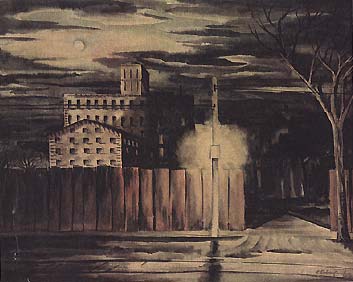|
Toronto the Good is not very good in its early days. York's first jail is built in York in 1798. In 1800, the town's first recorded crime involves two felons robbing a tavern. One is publicly lashed, the other has his hand branded. Infidelity leads to York's first duel when the Governor's Councillor, John Small shoots Attorney-General John White, who is "seeing" Mrs. Small. Two years later another woman catches the public's attention. Mrs. Ellis and her husband Stephen are charged with running a brothel. Stephen gets off, but Mrs. Ellis is put in the stocks and jailed for six months. Toronto eventually grows protective of its Protestant core. In 1859, Orangemen are forbidden to drink or meet in hotels, taverns, or saloons. Joining Temperance Lodges is encouraged. Sunday sporting events aren't allowed until the 1950s. But a seamier city seethes under the restraints of Toronto The Good. From the notorious red-light district of Lombard street in the 1830s to the Yonge Street Strip of Starvin' Marvin's strip club in the 1970s, vice flourishes.
 |
|
Moon over the Don Jail, 1938, by Carl Schaefer |
Prostitution is a constant pre-occupation in Toronto. In 1831, progressive Reformer Francis Collins, the first Catholic journalist, howls in his "Canadian Freeman" about brothels. "More shameless debauchery was never exhibited in Sodom and Ghomorrha, than is carried on in this town at present. Houses of infamy are scattered thro' every corner of the town - and one of them had the hardihood to commence operations next door to our office, in a house under the control of a Police magistrate! So besotted are some would-be gentlemen, that they crowded to it at noon-day and in open day on the Sabbath."
 |
|
City Lights, 1945, by Tom Roberts |
Another writer, Ernest Hemingway sniffs out vice in his years at the Toronto Star with stories about betting and drinking. Repeated campaigns are launched by the Women's Christian Temperance Movement to save wives and families from the demon drink. Mayor Howland campaigns on a platform of reform in 1886. "The Whiskey men have shown how they mean to fight, but we are going to lick them and suppress their groggeries." Mayor Howland establishes Toronto's 1st Morality Department in 1886.
In the 1890s, the grandson of Rebel William Lyon Mackenzie, studies law at U of T. Mackenzie King, the future prime minister, seeks out prostitutes at night, encouraging them to turn to God. Toronto's balancing act between outrage and tolerance continues along the moral fault lines of abortion, gay baths and lap dancing.
 |
|
Midnight at Charly's, 1945, by William A. Winter |
Crime does not pass Toronto by, though the organized kind arrives only in the 1960s. Twelve year old Red Ryan is a bicycle thief in 1907; a year later he's in reform school for stealing chickens. After years of burglaries, murders and escapes, Ryan convinces a priest that he's gone straight. The press play it up and even Prime Minister Bennet comes for a visit. Ryan is granted an early parole on a new wave of penal reform. For months he plays the celebrity while clandestinely robbing and killing. He's finally shot dead at a liquor store heist and newspaper ink runs red with who to blame.
|
